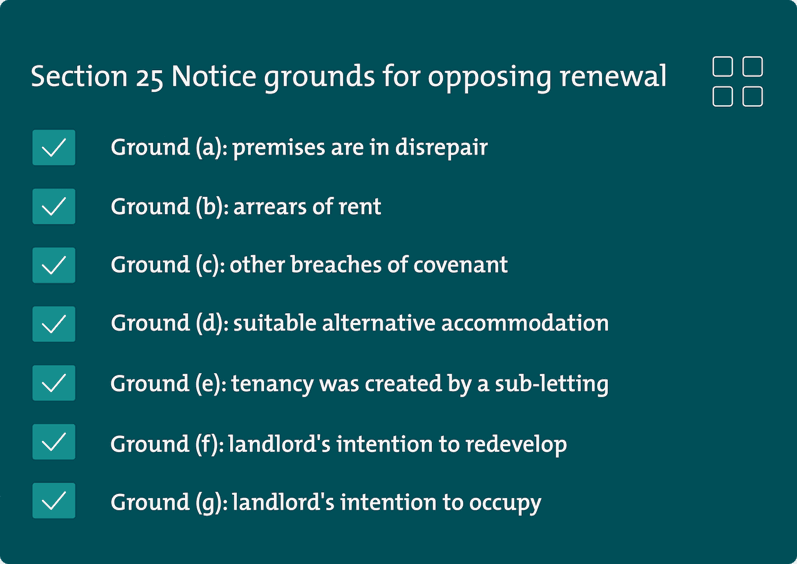In this guide to Section 25 Notices, we explain their purpose, legal requirements, serving methods, and effective responses in various contexts.
The Landlord and Tenant Act 1954 contains provisions and protections relating to business tenancies which fall within the scope of the Act, and lays down a procedure for termination of leases that are protected by the Act.
Leases protected by the Landlord and Tenant Act will not simply come to an end on the contractual expiry date. For example, a business tenancy for a fixed term of 10 years will not end on the expiry of 10 years, unless terminated within the procedures set out in the Act. The lease will continue under section 24(1) of the Act on the same terms unless terminated in accordance with the Act.
A key part of the processes set down in the Landlord and Tenant Act is the requirement for the parties to serve a notice to make clear their intentions.
When and why Section 25 Notices are issued
Types of Notices under the Landlord and Tenant Act
- a landlord can serve a Section 25 Notice initiating renewal of the lease and stating the terms on which it is willing to renew
- a landlord can serve a Section 25 Notice stating it opposes renewal on one of the statutory grounds specified in section 30(1) of the Landlord and Tenant Act
- a tenant can serve a Section 26 Notice stating it wishes to renew the lease and setting out the terms on which it wishes to renew
- a tenant can also serve a Section 27 Notice stating it does not require a renewal. These are relatively uncommon.
Section 25 Notice proposing terms for renewal
Where a landlord serves a Section 25 Notice offering renewal, the notice will set out the proposed terms and also the date on which the current lease will terminate. Either party may apply to court for a new lease by the date specified in the notice, (section 29A(2)(a) of the Act).
This date can be extended by written agreement and the parties are free to negotiate terms at any time.
In the event that proceedings are issued, the claim will be an unopposed lease renewal claim, i.e. it will be a claim to decide the terms of the new lease, not whether there will be a renewal, (as the tenant is entitled to this following service of the notice).
Section 25 Notice opposing renewal
Where a landlord serves a Section 25 Notice opposing renewal it will need to specify one or more of the grounds set out in section 30(1) LTA 1954, which are:
- Ground (a): premises are in disrepair
- Ground (b): arrears of rent
- Ground (c): other breaches of covenant
- Ground (d): suitable alternative accommodation
- Ground (e): tenancy was created by a sub-letting
- Ground (f): landlord's intention to redevelop; and
- Ground (g): landlord's intention to occupy.
A tenant will be entitled to compensation if a renewal is denied on any of grounds (e), (f) and (g) which are known as “no fault” grounds.
The tenant will lose a right to renewal unless an application is made to court by the date specified in the notice, (section 29A(2)(a) of the Act).
Either party, (but typically the tenant), may issue an opposed lease renewal claim for a new lease whereby the court will decide whether a lease will be granted and, if so, the terms of the new lease.

Legal requirements and compliance
The Section 25 Notice must be in a prescribed form. There is a form for opposing renewal and a form to be used where a landlord is not opposing renewal.
A Section 25 Notice can be served up to 12 months before the end of the contractual term of the lease, or after the end of the contractual term, but also not more than 12 months nor less than six months before the termination date specified in the notice.
A Section 25 Notice may not be served if the landlord has already served a valid Section 25 Notice or if the tenant has served a valid Section 26 Notice.
The notice must:
- be served by the competent landlord and state their name and address; this will be the immediate landlord if they have freehold interest or a leasehold interest that will not come to an end within 14 months. If it is not the immediate landlord, it will be the next in the chain of landlords provided they satisfy these conditions
- be served on the tenant; this will be the party occupying the premises pursuant to a business tenancy for the purpose of its business and could be a sub-tenant as well as the landlord’s immediate tenant. A landlord should consider whether it should also serve notice on any subtenants
- state a termination date; this cannot be earlier than the contractual expiry date of the lease.
Serving Section 25 Notices
By section 23 of the Landlord & Tenant Act 1927, a notice will be deemed served on the day it is posted if served by registered post to the tenant’s last known work or residence (if an individual), or its registered office (in the case of a company), by leaving the notice as this address or by personal service.
The notice should be sent by recorded post or special delivery and a record of the tracking number should be retained and checked. If the notice is served personally, the person serving should make a contemporaneous note confirming when, how and on whom the notice was served.
For further information on Section 25 Notices, contact our property litigation solicitors.

